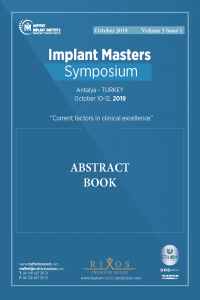Öz
Introduction: The purpose of dental implant construction is not only to swallowing and chewing functions, but also to meet cosmetic requirements. As a result of systemic and local factors such as trauma, early tooth loss, periodontal diseases, tumor surgeries and MRONJ (medical related of necrosis of jaw), advanced horizontal and vertical bone resorption may occur in the alveolar structure of the jaw bones. Conventional total prosthesis, block or alveolar split grafting, iliac graft, interposition grafting for surgical and prosthetic rehabilitation in patients with highly resorbed total edentulous maxilla; Implants supported by advanced surgical procedures such as Le Fort I osteotomy, external sinus lifting and combination of these procedures are among the treatment alternatives. A 58-year-old healthy ASA-1 class female patient who was admitted to our clinic for tooth deficiency, inadequate chewing, mobile teeth and poor oral hygiene was diagnosed with advanced maxillary atrophy as a result of CBCT, panoramic examination and intra-oral examination. Case Report: The patient underwent midcrestal incision maxillary alveolar bone under general anesthesia.4 zygomatic implant application was performed. Sufficient amount of alveolar bone in the lower jaw of the patient 4 standard dental implants were performed following the extraction of the residual teeth in the same session. The surgical site was closed primarily, and the patient had prosthetic rehabilitation immediately. Discussion & Conclusion: Due to the density of the zygomatic bone, implants can be loaded with a torque value above 50N / cm. Immeadiate loading is possible. The presence of important anatomical structures such as the facial nerve, intra-orbital nerve, and maxillary sinus at the site of surgical application may result in maxillary sinusitis, nerve complication and complication rate of surgery increases. Because it provides immediate loading to patients with severly atrophic maxilla resulting from extensive resection due to trauma, cyst and tumor surgery, there is no need for a extra surgery and the success rate of zygoma implants has been reported to be between 90-100% in different studies in the literature. The popularity of zygomatic implants has increased. Keywords: Zygomatic implants.
Anahtar Kelimeler
Kaynakça
- .
Ayrıntılar
| Birincil Dil | İngilizce |
|---|---|
| Konular | Diş Hekimliği |
| Bölüm | Makaleler |
| Yazarlar | |
| Yayımlanma Tarihi | 13 Ekim 2019 |
| Yayımlandığı Sayı | Yıl 2019 Cilt: 3 Sayı: 1 |


